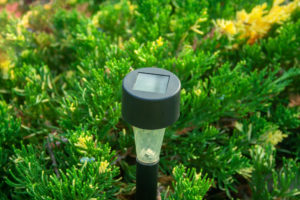Outdoor solar lights have become increasingly popular for their energy efficiency and eco-friendliness. They harness the sun’s power to illuminate your pathways, gardens, and outdoor spaces. However, one question often perplexes homeowners: “Do I need to remove the protective film from solar lights?” In this comprehensive guide, we’ll explore the ins and outs of this protective film and whether or not it should be peeled off for optimal performance.
Contents
- 1 Key Takeaways
- 2 The Protective Film: What Is It?
- 3 Benefits of Protective Film
- 4 When to Remove the Protective Film
- 5 How to Remove the Protective Film
- 6 Impact on Solar Panel Efficiency
- 7 Expert Insights From Our Solar Panel Installers About Removing Protective Film from Solar Lights
- 8 Our Expertise in Solar Lights
- 9 Conclusion
Key Takeaways
- Always consult your solar light’s user manual and follow the manufacturer’s recommendations regarding removing the protective film.
- If you notice diminished illumination, visual damage to the film, or the solar lights have aged, it may be time to consider removing the protective film.
- When you decide to remove the film, do so carefully by turning off the solar light, peeling it off slowly, and disposing of it responsibly to maintain the efficiency and longevity of your outdoor solar lights.
The Protective Film: What Is It?
The protective film, often a clear plastic film, is a crucial component of your solar lights. It’s primarily placed on the solar panel, which converts sunlight into electricity. This film serves as a shield, guarding the solar panel against potential damage during transportation, handling, and installation.
Benefits of Protective Film
Protection During Installation
When you first receive your outdoor solar lights, they are equipped with this film to prevent scratches, smudges, or any other damage during installation. It ensures that your solar panel arrives in pristine condition.
Preventing Damage
As you handle the solar light during installation, there’s a chance it might accidentally scrape against a hard surface or get dirt on it. The protective film acts as a sacrificial layer, absorbing minor damage that might otherwise harm the solar panel beneath.
Maintaining Efficiency
The clear plastic film is designed to be transparent to sunlight. While in place, it allows sunlight to pass through, ensuring that the solar panel can still effectively charge the battery. It helps maintain the efficiency of your solar lights until it’s time for removal.

When to Remove the Protective Film
The decision to remove the protective film from your solar lights depends on various factors, but the most critical is your solar light’s user manual. Always follow the manufacturer’s recommendations tailored to your specific product.
Aside from the user manual, here are some general signs that it might be time to peel off the film:
- Dim Illumination: If your solar lights aren’t shining as brightly as they used to, it could be due to the protective film reducing the sunlight reaching the solar panel.
- Visual Damage: Check the film for visible damage, like tears or scratches. If you notice any, it’s best to replace it.
- Aging: If you’ve had your solar lights for a while, the film might have served its purpose, and it’s a good idea to remove it for optimal performance.
How to Remove the Protective Film
When it’s time to remove the protective film, follow these steps for a hassle-free process:
Gather Necessary Tools
For this task, you’ll need a few basic tools: a clean, lint-free cloth and a gentle adhesive remover (if necessary).
Turn Off the Solar Light
Ensure your solar light is turned off to prevent any accidental activation while you work on it.
Locate the Film
Identify the protective film covering the solar panel. It’s usually a thin, clear layer on top.
Carefully Peel off the Film
Gently lift one corner of the film and start peeling it off slowly. Take your time to avoid leaving any residue or damaging the solar panel.
Dispose of the Film Responsibly
Dispose of the removed film responsibly, following local recycling or disposal guidelines for plastic materials.

Impact on Solar Panel Efficiency
The protective film’s presence or absence can impact your solar lights’ efficiency. Here’s what you need to know:
- With Protective Film: When the film is intact and in good condition, it has a minimal impact on solar panel efficiency. The film is designed to allow sunlight to pass through, ensuring your panels can charge the battery effectively.
- Without Protective Film: Once you remove the film, your solar panel receives direct sunlight, potentially increasing efficiency. However, the difference in efficiency might not be substantial, especially if the film was in good condition.
Expert Insights From Our Solar Panel Installers About Removing Protective Film from Solar Lights
Leaving the protective film on the solar panel can slightly reduce its efficiency. However, it’s crucial to follow the manufacturer’s instructions regarding its removal to avoid any damage.
Senior Solar Technician
Inspecting the film for any signs of damage is essential. If you notice tears or scratches, it’s time to remove the film to ensure optimal performance of your solar lights.
Lead Installer
Removing the protective film carefully is vital to prevent scratching the solar panel. Always turn off the light before you start and peel off the film slowly.
Solar Energy Consultant
Our Expertise in Solar Lights
At Solar Panels Network USA, we’re here to provide you with valuable information and support regarding solar lighting. With our experience and understanding of the solar lighting industry, our team of experts is prepared to assist you in finding the right lighting solution for your needs. Whether you’re interested in improving your outdoor spaces, conserving energy, or adopting a more sustainable approach, we’re well-equipped to help. Please feel free to contact us with any questions or inquiries.
Conclusion
The protective film on solar lights serves a vital purpose in safeguarding the solar panel during transportation, installation, and early use. While it may slightly reduce efficiency, it’s typically best to keep it on until you notice signs of wear or dim illumination. Following manufacturer recommendations and the steps outlined in this guide, you can ensure that your outdoor solar lights remain bright and efficient for years.
Remember, when removing the protective film, do so carefully to avoid damage to the solar panel, ensuring that your solar lights continue to charge and illuminate your outdoor spaces effectively.
About the Author
Solar Panels Network USA stands at the forefront of solar energy solutions, driven by a team of seasoned solar engineers and energy consultants. With over decades of experience in delivering high-quality solar installations and maintenance, we are committed to promoting sustainable energy through customer-centric, tailored solutions. Our articles reflect this commitment, crafted collaboratively by experts to provide accurate, up-to-date insights into solar technology, ensuring our readers are well-informed and empowered in their solar energy decisions.

